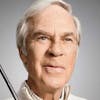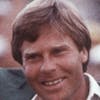
Crenshaw, Ben
Golf Professional and Golf Course Architect
For a man known for his love of golf history, Ben Crenshaw has been involved in quite a bit of it. From his beginnings with a Hall of Fame teacher to dominating the college level to emotional highs at the Masters and the 1999 Ryder Cup, Crenshaw has etched his name into some of golf’s most famous moments.
Crenshaw was introduced to the game by his father, Charlie, a schoolteacher. When Crenshaw was 8, his father placed him under the guidance of Harvey Penick, a teacher of such skill that he would eventually find his own locker at the World Golf Hall of Fame. Penick cut down a 7-iron for him, showed him a proper grip and watched as Crenshaw effortlessly whacked balls onto the green 75 yards away.
“Now let’s go to the green and putt the ball into the hole,” Penick told his new student. “If you wanted it in the hole, why didn’t you tell me the first time?” responded the first-time golfer, according to Penick’s best-selling Little Red Book.
“I’m going to leave y’all with one thought. I’m a big believer in fate. I have a good feeling about this.” (From Crenshaw’s press conference the day before the historic comeback by the U.S. in the 1999 Ryder Cup.)
Finding the hole was never a problem for Crenshaw, who was blessed with a putting stroke that would become his calling card. Charlie Crenshaw Sr. remembers when he bought his teenage son the Wilson 8802 blade putter that came to be known simply as “Little Ben.” “It was just a putter in Harvey Penick’s shop. Ben felt it and waggled it around for a while so I bought it for him. That club’s been the best provider in the family,” he said of the $20 club. Crenshaw used it to perfect the art of what he called “the dying putt.”
“The ball which arrives at the hole with the proper speed has an infinitely greater chance of falling in the hole from any entrance,” Crenshaw wrote in The Legend of Bobby Jones: The Greatest of Them All. “Harvey Penick taught me the value of this method at an early age. This is what he meant by ‘giving luck a chance.’”
Crenshaw’s putting was so sensational it often overshadowed the rest of his game. His 19 PGA TOUR titles, including two Masters wins, and exemplary record prove that his overall game was as accomplished as his putting.
Few golfers have joined the PGA TOUR with greater expectations to succeed than Crenshaw. After winning 17 amateur events, including the NCAA title from 1971 to 1973 while an All-American at the University of Texas, Crenshaw had the strongest amateur resume since Jack Nicklaus.
After he turned pro, he lapped the field at qualifying school by 12, won his first PGA TOUR start, and the following week finished second. He seemed preordained to challenge Nicklaus’ record, but victories at the Majors eluded him.
FACT
AS PART OF THE COORE & CRENSHAW GOLF COURSE ARCHITECTURE TEAM, CRENSHAW HAS HELPED DESIGN A SLEW OF HIGHLY RANKED COURSES, INCLUDING SAND HILLS GOLF CLUB IN NEBRASKA AND THE KAPALUA PLANTATION COURSE IN HAWAII.
“Not winning a Major for my first 11 years was difficult to accept given the number of good chances I had,” Crenshaw said in his autobiography. “But in the end, the tough losses made my victories at Augusta even sweeter.”
Crenshaw finally answered his critics in 1984 by capturing his favorite event, the Masters. Lurking two shots behind heading into the final round, Crenshaw put on a putting exhibition the likes of which was seldom seen. Walking up the 18th fairway en route to a 4-under 68, Crenshaw at last was triumphant on golf’s largest stage.
Eleven years later, he won his second Masters seven days after he learned that Penick had died. Crenshaw showed up at Augusta with a heavy heart and his game in disarray. Golf’s foremost putter entered the Masters ranked 69th in putting that season, but a swing tip from his caddie, Carl Jackson, and one last putting tip from his mentor rejuvenated his game. Two weeks before Penick died, Crenshaw visited him and the ailing pro gave his 43-year-old student one final lesson from his bed.
Crenshaw’s magical stroke returned. He mastered Augusta’s slippery surfaces, surviving the tournament without making a single three-putt. He authored a final-round 68 that included “a Harvey bounce” off the trees at the second and birdies at 16 and 17 to close one of the tournament’s most improbable victories.
It was a signature moment, with one more to come. Crenshaw was the captain of the U.S. team at the 1999 Ryder Cup at the Country Club in Brookline, Massachusetts, and by Saturday, he looked every bit the loser. The U.S. was down 10-6 going into the Sunday singles matches. No team had ever overcome such a deficit.
But Crenshaw, emotional and defiant, a historian at heart, used every bit of his stubborn Texas upbringing and knowledge of the game to inspire his team. And when Justin Leonard clinched the win with his 45-foot prayer of a putt on the 17th hole, Crenshaw had left another unforgettable mark on the game he loves so dearly.
Ben Crenshaw - Part 3 (The Ryder Cup and the Majors)
We begin with the 2-time Masters Champion in the 18th fairway of the final round of his emotional Masters win in 1995. He tells of his enduring love of his long-time caddie, Carl Jackson and how Carl’s perceptive eye spotted …
Ben Crenshaw - Part 2 (The Masters Tournament)
We continue our discussion with World Golf Hall of Fame member Ben Crenshaw for a recap of his professional stats, including his surprising (0-8) record in playoffs, winning his first professional event and reliving a few of ...
Ben Crenshaw - Part 1 (The Early Years)
World Golf Hall of Fame member, Gentle Ben looks back on his youth, learning the game under the watchful eye of Harvey Penick, his second father, and being challenged by a young Tom Kite. Learn about the eerie history of …


